The harlequin ladybird (Harmonia axyridis) is also known as the multicoloured Asian ladybird and the Halloween Ladybird. It has a very variable appearance, which can make it difficult to tell apart from some of our native ladybirds!
The descriptions below should help you, and there are lots of ladybird images for you to see at the bottom of the page.
Download the ladybird identification sheet to help you distinguish the harlequin ladybird from other native British ladybirds.
Basic description of a harlequin ladybird
- Size and shape : large (7-8 mm), round
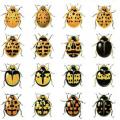
- Elytra (wing case) ground colour: pale yellow-orange, orange-red, red or black; highly variable
- Elytra pattern: 0-21 orange-red or black spots, or grid pattern; highly variable
- Most common forms in UK : orange with 15-21 black spots: black with two or four orange or red spots
- Pronotum pattern: white or cream with up to 5 spots or fused lateral spots forming 2 curved lines, M-shaped mark or solid trapezoid
- Other characteristics: elytra with wide keel at base; legs almost always brown
Harlequin ladybird (H. axyridis) - some of the colour variants | ||
[caption caption='H.axyridis-succinea']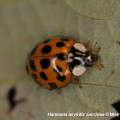 [/caption] [/caption] | [caption caption='H.axyridis-spectabilis']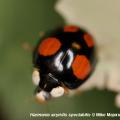 [/caption] [/caption] | [caption caption='H.axyridis-conspicua']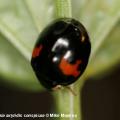 [/caption] [/caption] |
[caption caption='H.axyridis-larva']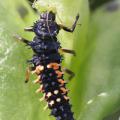 [/caption] [/caption] | [caption caption='Larva_Pupa']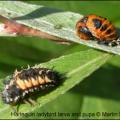 [/caption] [/caption] | [caption caption='Vaiability_Harlequine_Ladybird']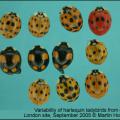 [/caption] [/caption] |
[caption caption='Harlequin_2-Spot'] [/caption] [/caption] | [caption caption='Harlequine_Pine-ladybird'] [/caption] [/caption] |
Distinguishing the harlequin ladybird from other British species
- If its less than 5 mm in length, it is definitely not a harlequin ladybird.
- If its red with precisely 7 black spots, it is a 7-spot ladybird.
- If it has white or cream spots, it is a striped ladybird, an orange ladybird or a cream-spot ladybird.
- If it is large, burgundy coloured and has 15 black spots, it is an eyed ladybird
- If it has an orange pronotum, and fine hairs all over the elytra, it is a bryony ladybird.
- If it is black with four or six red spots, two of which are right at the front of the outside margin of the elytra, it is a melanic form of the 2-spot ladybird.

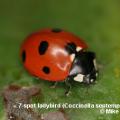 [/caption]
[/caption]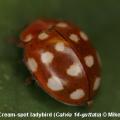 [/caption]
[/caption]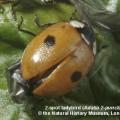 [/caption]
[/caption]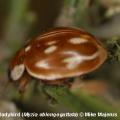 [/caption]
[/caption]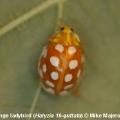 [/caption]
[/caption]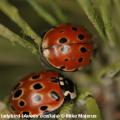 [/caption]
[/caption]